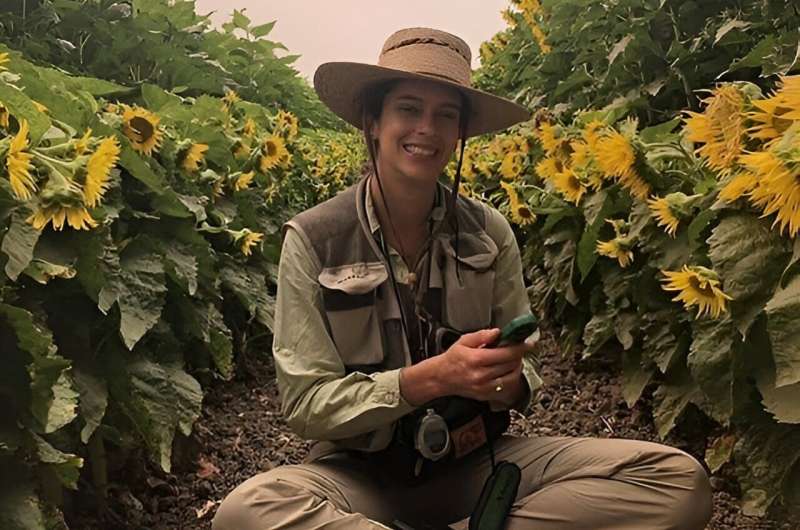This article has been reviewed according to Science X's editorial process and policies. Editors have highlighted the following attributes while ensuring the content's credibility:
fact-checked
peer-reviewed publication
trusted source
proofread
Single-crop farming has potential to harm bees, study finds

Mass-blooming, monoculture crop fields don't seem to reduce the microbial diversity in a bee's gut, University of Oregon researchers have found in a study of sunflower farms, but they do amplify the spread of infectious parasites.
Their findings indicate that commercial agriculture—which is currently dominated by farms that grow one crop type—has the potential to harm bee health. Installing strips of diverse vegetation alongside crops can serve as alternative resources that protect pollinators from infectious diseases, the researchers said.
When a bee visits a flower, it's time to both feast and release. Through their food and waste, bees can swap microbes and potentially alter their gut microbiome, a rich, internal ecosystem crucial for maintaining digestive and bodily health.
Mass-flowering, single-crop fields, such as sunflowers, are loaded with nectar, which can lure massive numbers of pollinators and therefore increase the chances of microbial transmission. As such, UO researchers anticipated they might restructure and homogenize the vital microbial diversity within bees.
Contrary to their expectations, bees visiting monocultures didn't lose that diversity, said Lauren Ponisio, an assistant biology professor in the College of Arts and Sciences and Institute of Ecology and Evolution.
"It's a hopeful story for bees living in these industrial agricultural systems because they still seem to be able to acquire the microbes they need from different places," said Ponisio, also known as the "Queen of Bees" for her research on pollinators. "They don't just lose all their diversity due to mass-blooming crops."
In research described in a paper published Feb. 27 in the journal Molecular Ecology, the researchers visited sunflower fields in Yolo County in Northern California, just west of Sacramento.
"These fields are definitely interesting places to work," said Gordon Smith, a former UO postdoctoral researcher. "It's you, your big sun hat and your insect net, and you're trying to take a look at what kinds of bees are visiting these plants."
These mass-flowering sunflower farms attract all kinds of bee species during their vast, synchronized bloom and can act as a hub not only for pollen and nectar but also waste, beneficial microbes and parasites. According to the researchers, the spread of disease is one of the main drivers of population decline among insect pollinators.
Unlike the decades of research on the human gut microbiome, however, bee guts haven't been studied much before, said Smith, now a visiting professor of biology at Williams College.
"We know from all the work in human gut microbiomes that the composition, the relative abundance of different microbial species, alone can have large impacts on things like your mood, food digestion and food preferences," he said. "There are a lot of nuanced effects on your behavior just based on what's living in your gut. But what are those more subtle effects in bees and where do their microbes come from?"
The research also was an opportunity to take a glimpse into the lives of wild bees, including bumblebees. Scientists are familiar with the popular honeybee, but other bees such as sunflower bees are quite different, Smith said. They don't live in colonies within hives; instead, each female bee makes her own nest underground, he said.
"So if you're not bumping into 1,000 other colony mates or sharing honey pots, the opportunities for transmission might cause microbial species, parasitic or not, to propagate very differently," he said. "But we don't know how often that transmission happens, or if it's happening in the first place."
To confirm if flowers are hubs for bacterial transfer, the researchers delicately brushed off the floral pollen captured on the bees' legs and analyzed it alongside their gut microbiome to find correlations.
Results showed that the kinds of flowers the bees visited moderately predicted the types of microbes they carried in their gut, indicating evidence of transmission via flowers. The researchers wondered if this bacterial pickup would cause a significant change in the bees' overall gut compositions. In fact, if most bees visited the same monocultural resource—sunflowers, in this case—they could be passing around and sharing the same bacteria.
In other words, their microbiomes would homogenize and be less diverse, the researchers hypothesize.
To their surprise, their microbiomes remained highly varied. Ponisio said that suggests the critters have barriers, like a filtering process in their gut, to prevent significant changes in their bacterial composition.
As flowers weren't the main drivers of bacterial variation in the bees, the study indicates a need to identify other sources of bee microbes, Ponisio said.
Although sunflower monoculture didn't significantly affect bee microbiomes as a whole, additional research done by the team found it magnified the prevalence and spread of certain known infectious parasites. That effect, however, was dampened if there were more diverse flowers nearby.
It's unknown if all mass-blooming crops amplify parasitism, but installing strips of diverse vegetation, known as hedgerows, can support bees as an alternative resource and protect against infection, Ponisio said.
Ponisio and her lab have been working to make agriculture better for wildlife and people through land restoration and enhancement. She plans to explore more diverse systems, like high-elevation meadows, to dig deeper into how species differences influence their gut microbiomes.
"Just as we need to work to preserve the habitats bees live in," she said, "we also need to work to preserve the habitats living within bees."
More information: Gordon P. Smith et al, Plant–pollinator network architecture does not impact intraspecific microbiome variability, Molecular Ecology (2024). DOI: 10.1111/mec.17306
Journal information: Molecular Ecology
Provided by University of Oregon


















